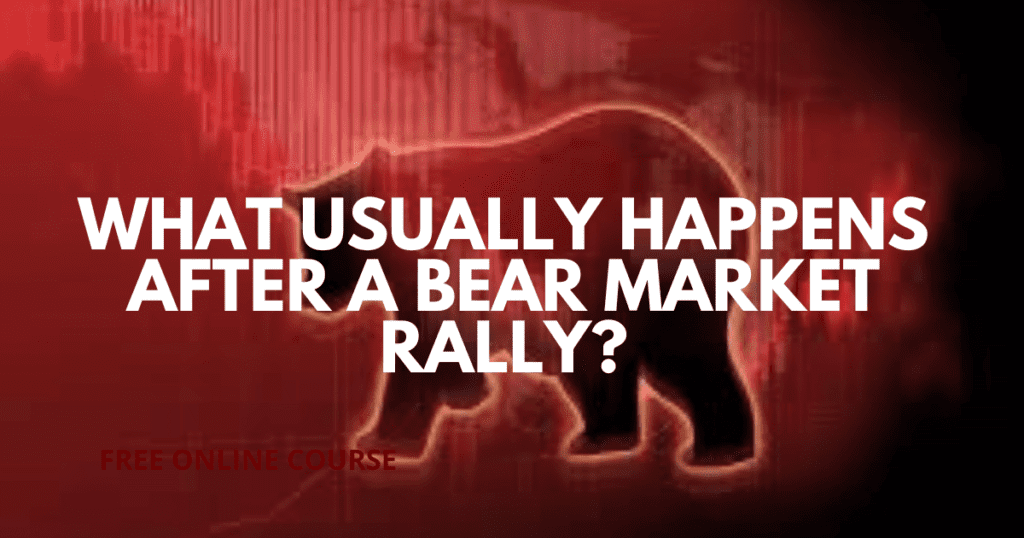Discover the crucial insights into the post-bear market rally landscape. Explore strategies to make informed decisions in uncertain times. The financial landscape is in a constant state of flux, marked by periods of both growth and decline. One specific phrase that captivates the attention of both investors and analysts is the bear market rally.
In this comprehensive article, we will delve deep into the intricacies of the typical occurrences after a bear market rally, thoroughly examining the various factors, trends, and potential outcomes that shape this phase.
Understanding Bear Market and Bear Market Rally
Before we immerse ourselves in the aftermath of a bear market rally, it is imperative to have a clear grasp of what a bear market and a bear market rally truly entail. A bear market is characterized by a prolonged period of extensive decline in asset prices, often leading to a drop of 20% or more from recent highs. On the flip side, a bear market rally refers to a fleeting resurgence within a bear market. During this period, asset prices experience an upward trajectory before the potential continuation of their downward path.
Factors Influencing Bear Market Rallies
Diverse catalysts can initiate a bear market rally, even amid an overarching bearish market sentiment. These factors encompass an array of scenarios, such as improvements in economic indicators, governmental interventions, shifts in investor sentiment, and external geopolitical events. Delving into the underpinnings of bear market rallies unveils insights into the sustainability of these recoveries.
Unveiling the Dynamics of a Bear Market Rally
Bear market rallies boast distinctive dynamics that set them apart from other phases within the market. Throughout a rally, emotions such as fear and greed wield substantial influence, molding investor decisions and market trends. A profound comprehension of these dynamics empowers investors to navigate the intricacies of the post-rally environment with acumen.
Exploring Historical Instances of Bear Market Rallies
The annals of history bear witness to noteworthy instances of bear market rallies that have seized the attention of financial pundits. Scrutinizing these examples, including the rebound from the 2008 financial crisis, provides invaluable insights into the potential trajectory of markets following a bear market rally.
Evolving Market Sentiments During and Post-Rally
Vigilantly monitoring market sentiments during and after a bear market rally is of paramount importance. Positive sentiments amid a rally can usher in heightened risk-taking proclivities, whereas sentiments post-rally might wield influence over cautious investment strategies. An in-depth analysis of the evolution of market sentiments unveils potential market trends.
Transitioning Towards a Bull Market
The transition from a bear market rally to a bull market stands as a pivotal phase that signals a potential shift in market dynamics. Grasping the signs that signify the culmination of a bear market rally and the inception of a bullish trend is pivotal for investors keen on capitalizing on emerging prospects.
Impact on Various Asset Classes
Bear market rallies exert non-uniform impacts across diverse asset classes. While some assets may enjoy substantial gains during a rally, others might continue to grapple. A comprehensive exploration of the varied impacts on asset classes, encompassing equities, bonds, commodities, and cryptocurrencies, empowers investors to craft judicious decisions.
The Nexus of Government and Central Banks
The actions of governments and interventions by central banks cast a significant shadow over the aftermath of a bear market rally. Measures such as stimulus packages and adjustments in interest rates can wield influence over market liquidity, investor sentiment, and the broader economic resurgence.
Strategies Embraced by Investors Post-Rally
Investors adopt a mosaic of strategies during the post-rally phase to navigate the labyrinth of potential market uncertainties. Some opt to lock in profits, while others set their sights on long-term investment prospects. A meticulous examination of these strategies bestows insights into how investors acclimate to the mutable market conditions.
Steering Clear of Common Pitfalls
Traversing the post-rally terrain is fraught with its own set of challenges, and investors frequently stumble upon common pitfalls that can impede their financial aspirations. Identifying and circumventing these blunders, such as hubris and neglect of risk management, form the cornerstone of triumph in a recuperating market.
The Psychological Underpinnings: Fear and Greed
Psychological facets like fear and greed exert substantial influence over investor behavior both during and after a bear market rally. A comprehensive comprehension of the psychological facets of trading and investment decisions equips investors to make judicious choices, transcending impulsive emotional responses.
Potential Impediments in a Post-Rally Rebound
While bear market rallies kindle hope for recovery, they remain susceptible to potential impediments that can hinder progress. Elements such as economic fragility, unforeseen occurrences, and structural vulnerabilities can cast shadows over the sustainability of a post-rally resurgence.
The Vital Role of Economic Indicators
The vigilant monitoring of economic indicators is indispensable for gauging the health of the post-rally economy. Metrics like GDP growth, unemployment rates, and consumer spending serve as windows into the trajectory of economic resurgence and its potential reverberations across markets.
Balancing the Long-Term and Short-Term Perspectives
Investors perennially wrestle with the conundrum of choosing between adopting a long-term or short-term outlook in a post-rally milieu. The art of harmonizing immediate gains with long-term viability assumes paramount significance and can steer the course of investment strategies.
Extracting Wisdom from Past Bear Market Rallies
Past bear market rallies proffer invaluable insights for both investors and financial savants. Scrutinizing the outcomes, missteps, and triumphs of previous recoveries presents a guiding light for formulating effective strategies and risk management during the post-rally juncture.
The Metamorphosis Fueled by Technology and the Information Era
The advent of the technology and information age has wrought a revolution in the functioning of markets. A meticulous dissection of how technological progressions and the democratization of information have imprinted their influence on market dynamics and trends augments our understanding of post-rally kinetics.
The Geostrategic Quotient: Influence and Implications
Geostrategic occurrences wield far-reaching implications for financial markets, even in the post-rally epoch. A nuanced comprehension of the sway of geostrategic factors, spanning trade tensions and global conflicts, is pivotal for prognosticating potential trajectories of the market.
Embracing the Ineluctable Rhythm of Market Cycles
Market cycles, inclusive of bear market rallies, stand as intrinsic features of the financial ecosystem. Acknowledging the inevitability of these cycles fosters the cultivation of a robust and adaptable approach to traversing market oscillations.
Decoding the 2008 Financial Crisis
The 2008 financial crisis stands as a seminal archetype of a bear market and the ensuing rally. A meticulous dissection of the causes, responses, and outcomes of this crisis unfurls insights into the manner in which markets can convalesce from profound downturns.
The Significance of Diversification in the Path to Recovery
Diversification stands as a cardinal principle of risk management, particularly in the milieu of a post-rally scenario. Exploring the ways diversified portfolios can assuage risk and amplify returns guides investors in crafting judicious decisions.
Navigating Volatility Amid the Post-Rally Epoch
Volatility remains an indelible hallmark of financial markets, even subsequent to a bear market rally. Strategies devised for navigating volatility, spanning options trading and dynamic asset allocation, emerge as bedrocks for upholding stability in a convalescing market.
Real Estate Markets and the Post-Rally Trajectory
The real estate sector shares an intricate symbiotic relationship with market cycles and can unfurl unique dynamics post a bear market rally. A meticulous scrutiny of how real estate markets respond to recovery unveils insights into the broader tapestry of economic trends.
Behavioral Finance Trends in the Aftermath of a Rally
Behavioral finance emerges as a potent force in sculpting market trends. A comprehensive exploration of post-rally behavioral finance trends, encompassing phenomena such as herd behavior and cognitive biases, sheds luminescence on plausible market trajectories.
Vigilant Watch Over Regulatory Metamorphoses
Regulatory transformations can precipitate shifts in market dynamics, particularly during the post-rally juncture. Sustained awareness of regulatory metamorphoses and their conceivable impact on investments emerges as a compass for forging adaptive financial choices.
Gazing Forward: Prognostications for the Uncharted Territory
While the post-bear market rally landscape remains cloaked in uncertainty, experts often cast their predictions about future market trends. An in-depth exploration of these prognostications, coupled with the factors that inform them, equips investors in bracing for plausible scenarios.
Conclusion
In summation, the aftermath of a bear market rally unfurls as an intricate and multifaceted juncture that merits meticulous analysis and contemplation. Grasping the dynamics, trials, and openings presented during this phase empowers investors to formulate enlightened decisions that dovetail with their financial aspirations.
Frequently Asked Questions
Q1. How Long Does a Bear Market Rally Persist?
Ans: A bear market rally typically endures for a brief interval, often spanning from several days to a few weeks. These ephemeral surges within a bear market can stem from various sources, including oversold conditions, short-covering, or positive news. However, they usually presage the continuation of the overarching bearish trend.
Q2. What Is the Average Duration of Bear Market Recovery?
Ans: The timeline for recuperation from a bear market fluctuates based on factors such as market circumstances, the severity of the decline, and external events. Historically, bear markets have taken around 1.5 to 3 years on average to rebound. Nonetheless, this timeframe exhibits significant variance.
Q3. Post Bear Market Performance: What to Expect?
Ans: Following a bear market, markets often enter a phase of recuperation and expansion, referred to as a bull market. Uplifting economic indicators, ameliorated investor sentiment, and governmental interventions collectively foster this phase of upward momentum.
Q4. Is Investing Advisable During a Bear Market?
Ans: Continuing to invest during a bear market can serve as a strategic approach for long-term investors. Market downturns can furnish opportunities to procure assets at lower valuations, potentially yielding higher returns upon the eventual recovery of the market. Nonetheless, individual financial objectives and risk tolerance merit due consideration.
Q5. What Is the Longest Bear Market Recovery Span?
Ans: The duration of bear market recovery is a variable. The Great Depression-era bear market of 1929 serves as a notable instance, requiring approximately 25 years to regain its pre-crash levels. Nevertheless, such extreme cases remain exceptional, with most bear markets undergoing shorter recovery durations.
Q6. Which Is the Lengthiest Bear Market in Recorded History?
Ans: The bear market of 1929-1932 during the Great Depression is often hailed as one of the lengthiest and most profound bear markets in history. Spanning around 3 years, this bear market was accompanied by a substantial plummet in stock prices. It stemmed from a confluence of economic factors, including the 1929 stock market crash and the ensuing economic downturn.
Looking for more tips and tricks on investing? Check out our comprehensive guide on investing for beginners on The Money Beez!


